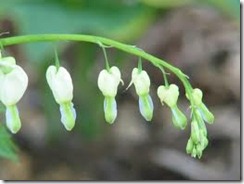Perennial bleeding hearts add color to shaded garden beds. The flowers form on the underside of pendulous flower stalks. Each blossom resembles a small heart with a petal droplet at the point, earning the bleeding heart its name. When provided with the proper growing conditions, the flowers return each year to grace the early season garden.
Soil Quality
-
Bleeding heart grows in well-drained soils that remain evenly moist. Sandy soils drain too quickly, causing the plants to flower poorly and decline earlier in the season. Soils with a heavy clay content retain too much moisture, which causes the roots of the flowers to rot. Loam soils provide the best choice for planting bleeding hearts. Adding compost to clay or sandy soils helps improve them so they retain the correct amount of moisture.
Fertility Needs
-
The high nutrient needs of bleeding hearts necessitates regular fertilization. A yearly application of a balanced, slow-release fertilizer in spring, as new growth begins, helps supply the necessary nutrients for the spring and early summer flowering season. Using a soluble fertilizer instead requires more frequent applications of once a month from spring until the foliage dies back. Bleeding hearts growing in beds without the proper fertility flower poorly and develop weak foliage.
Water Requirements
-
Regular watering provides the necessary soil moisture for the flowers. Spring soils retain moisture longer so may only need watering once a week, while drier conditions in summer may necessitate twice weekly watering. Soil must remain moist to a 6-inch depth, otherwise the plants quickly drop their blossoms and begin to decline. Spreading an organic mulch over the garden bed helps keep the soil moist and prevents it from drying too quickly during the warmer days of summer.
Sunlight and Temperature
-
Too much sunlight causes the bleeding heart plants to suffer wilting. Bright sunlight also dries the soil more quickly. Planting in partially shaded beds or those that only receive dappled sunlight helps keep the soil moist and prolongs flowering. The bleeding heart flowers in the cooler season of spring and early summer but flowers may persist longer in shady, cool beds. Locations protected from strong winds further prevent the soil from drying while also protecting the plants from damage.


Deprecated: strpos(): Passing null to parameter #1 ($haystack) of type string is deprecated in /home/agriviek8Qv/agriviet.net/public_html/wp-includes/comment-template.php on line 2522